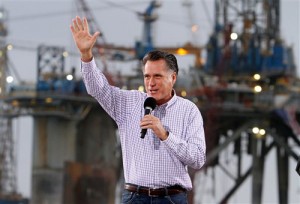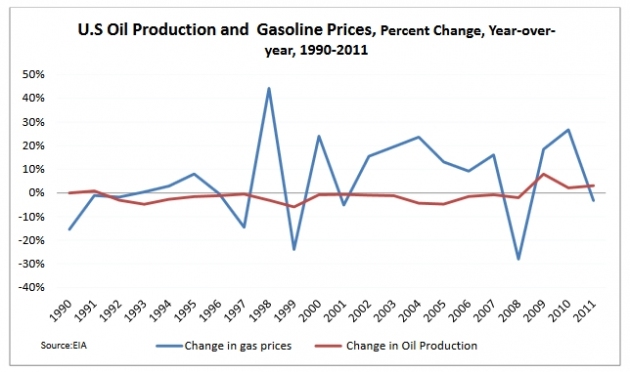By The Numbers: The Facts About Gasoline Prices
 During the first presidential debate, Gov. Mitt Romney was caught making misleading, incorrect, and flat out wrong statements. FactCheck.org concluded that “Romney often stretched the facts” during the debate. The New York Times Editorial Page Editor’s Blog noted that “Various truth squads have identified at least two dozen factual misstatements by Mitt Romney in 38 minutes of debate time on Wednesday night.”
During the first presidential debate, Gov. Mitt Romney was caught making misleading, incorrect, and flat out wrong statements. FactCheck.org concluded that “Romney often stretched the facts” during the debate. The New York Times Editorial Page Editor’s Blog noted that “Various truth squads have identified at least two dozen factual misstatements by Mitt Romney in 38 minutes of debate time on Wednesday night.”The myriad of misstatements in the first debate was not a unique incident, but is a frequent occurrence. The Romney campaign repeatedly dissembles on gasoline prices and other energy issues. Its latest blizzard of energy untruths were released this week in a memo to reporters.
Here are the facts about gasoline and other energy issues by the numbers.
Prices
•None: The Associated Press found “no statistical correlation between how much oil comes out of U.S. wells and the price at the pump” after examining 30 years of data (see chart below).

•$4 per gallon: “The average [gasoline price] exceeded $4 a gallon for seven weeks during the summer of 2008, and it has never reached $4 under Obama” according to USA Today.
•71 cents per gallon: increase in gasoline price since Speaker of the House John Boehner was sworn in.
•$23.39: added to the price per barrel of oil by “Speculation in Crude Oil” according to Forbes magazine.
•8 percent: cut in Commodities Future Trading Commission staff under House passed budget authored by Rep. Paul Ryan (R-WI). The CFTC polices oil markets to prevent Wall Street speculators from driving up prices.
Domestic oil production
•11 percent: increase in U.S. oil production between 2011 and 2012.
•41 percent: of U.S. oil imported in 2012.
•75 percent: increase in domestic oil rigs between 2009 and 2011.
•1993: last time the U.S. achieved projected 2013 domestic crude oil production of 6.9 million barrels per day.
Fuel economy
•27.5: miles per gallon fuel economy standard 1987-2010.
•54.5: miles per gallon fuel economy standard 2025.
•$8,200: average savings in reduced gasoline purchases over the life of a 2025 model year car compared to a typical 2010 car.
•2 million: barrels of oil per day saved by 2025 due to modern fuel economy standards.
Oil production in federal lands and waters
•241 million: barrels of oil, total increase in oil from produced from public lands and waters under first three years of President Obama compared to last three years of President Bush.
•60 days or less: amount of time it should take rig operators to receive permits under Department of Interior reforms.
•7,000: approved permits to drill for oil on public lands and waters held by oil companies that have not begun exploring or developing them.
•2/3: of “acreage leased by [oil] industry lies idle” according to the Department of the Interior.
Keystone XL pipeline
•None: amount of Canadian tar sands oil from Keystone XL pipeline guaranteed to be refined into fuel and sold in the U.S.
•0: number of new Canadian pipelines that will be built to transport tar sands oil to British Columbia to export to China, according to the Toronto Globe & Mail.
Hydraulic fracking
•1: federal regulation adopted under President Obama to regulate hydraulic fracking (requires reduction of smog and toxic air pollution from fracked and other wells).
•2: federal agencies that can establish standards to public health and vital resources from air and water pollution produced by fracking and other oil and gas production.
Big oil profits and tax breaks
•$60 billion: in profits earned by the big 5 oil companies — BP, Chevron, ConocoPhilips, ExxonMobil, and Shell — during the first 6 months of 2012.
•$137 billion: in profits earned by the big 5 oil companies in 2011.
•$2.4 billion: amount of existing annual special tax breaks for the 5 largest oil companies, according the Congressional Joint Committee on Taxation.
•$2.3 billion: amount of new tax breaks for big 5 oil companies in House passed budget authored by Rep. Paul Ryan (R-WI) and also included in Gov. Romney’s economic plan, according to an analysis by Center for American Progress Action Fund.
•$13: in federal oil and gas subsidies for every $1 in investment in renewable energy.
Oil industry support for Mitt Romney
•$3.6 million: in direct contributions from the oil and gas industry to the Romney for President campaign.
•$400 million: given by the Koch brothers and their network to pro-Romney super PACs and outside groups to broadcast misleading election ads to defeat Obama.
You can return to the main Market News page, or press the Back button on your browser.

